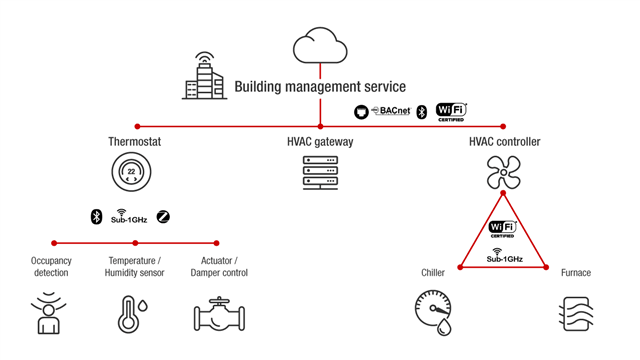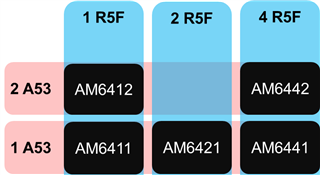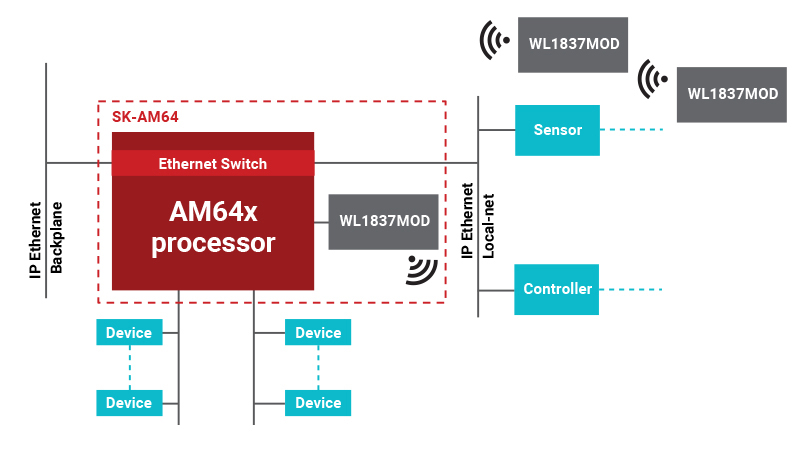SSZT163 may 2021 AM6411 , AM6442 , WL1837MOD
What do you think of when you hear the word “gateway”? The literal definition, “an opening that can be closed by a gate” or “a means of access or entry to a place,” makes sense in the context of electronics and our connected world, where a gateway provides a local network with access to another network or to the internet. In this article, I’ll explain some of the most important requirements for modern building automation gateways.
Connectivity
Gateways in building automation applications must make connections from the local network (the building itself or a group of devices in a building) to another network (a centralized location for monitoring multiple buildings) or to the internet (eventually reaching cloud servers).
There are two main classifications of connectivity, wired and wireless, although an effective gateway typically needs to have both. An Ethernet cable with an RJ45 connector makes the typical wired connection to the internet. Wireless connections to the internet occur through cellular networks, while wireless connections between devices use a variety of protocols in three frequency bands: <1 GHz, 2.4 GHz and 5 GHz. The most common protocol is Wi-Fi®, but it is also possible to use Zigbee®, Thread, Sub-1 GHz, Bluetooth® Low Energy and many other protocols.
In a completely wireless system, Wi-Fi turns the gateway into an end-point station to enable cloud connectivity. A gateway could also use an access point role or Bluetooth Low Energy for network provisioning. Figure 1 shows the various connectivity requirements for a heating, ventilation and air-conditioning (HVAC) gateway at the system level.
 Figure 1 Commercial Heating,
Ventilation, and Air Conditioning (HVAC) System
Figure 1 Commercial Heating,
Ventilation, and Air Conditioning (HVAC) SystemPerformance
Security
The definition of a gateway also implies the ability to close an opening. Security in some ways is the opposite of connectivity, preventing unwanted connections. Although the flow of information is fundamental to the implementation of a gateway, the ability to close the gate and prevent the flow of information is just as significant.
For building automation applications, security requirements for the processor include cryptographic acceleration, secure boot and a trusted execution environment. As far as wireless networking is concerned, the latest Wi-Fi Protected Access (WPA)3 security standard from the Wi-Fi Alliance took effect in July 2020 for personal and enterprise networks.
Putting It All Together
TI’s AM6442 processor includes connectivity and analytics capabilities that are synonymous with the requirements of gateways. The full range of the AM64x Arm®-based processors starts with the AM6442, combining dual Arm Cortex®-A53 cores and quad Arm Cortex®-R5F cores, down to a single Arm Cortex®-A53 and a single Cortex®-R5F core in the AM6411, as visualized in Figure 2.
 Figure 2 Arm Core Offerings for
AM64x
Figure 2 Arm Core Offerings for
AM64xTI’s WiLink™ 8 transceivers offer reliable Wi-Fi for gateways, with dual-band (2.4-GHz and 5-GHz) operation, multirole (simultaneous station and access point) capabilities, and integrated Wi-Fi Bluetooth coexistence in a single device. WiLink 8 integrated circuits and modules are also closely integrated with AM6442 hardware and software ecosystems to ease system development.
The AM64x starter kit evaluation module (EVM), or SK-AM64, combines connectivity, security and processing power on a single board. It includes a processor for your gateway application and an onboard Wi-Fi module (the WL1837MOD) that works right out of the box. The AM6442 delivers the necessary processing performance and meets security requirements and the onboard WL1837MOD provides 2.4- or 5-GHz Wi-Fi and Bluetooth 5.1 wireless connectivity. For wired connectivity, the board has two 1-Gbps Ethernet ports.
Figure 3 shows a simplified block diagram of the AM64x starter kit EVM, highlighting the components that are essential for turning this board into a wired-plus-wireless gateway suitable for building automation.
 Figure 3 SK-AM64 Gateway
Implementation
Figure 3 SK-AM64 Gateway
ImplementationYou can easily get started on your building automation gateway with a starter kit that includes the AM6442 and a WiLink 8 module. Combine this hardware with the latest Linux software development kit which starts up with Wi-Fi in access point mode, and you have a Linux gateway, enabling you to start developing your next project. Buy your SK-AM64, plug in a single USB-C cable for power, and get connected in minutes.